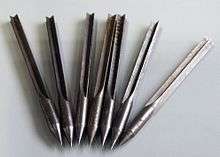Flechette

A flechette /flɛˈʃɛt/ fleh-SHET is a pointed steel projectile, with a vaned tail for stable flight. The name comes from French fléchette, "little arrow" or "dart", and sometimes retains the acute accent in English: fléchette.
Air-dropped flechette

In World War I, darts, also known as flechettes were dropped from aircraft to attack infantry.[1]
Small-arms ammunition

Small-arms makers are attracted by the exterior ballistic performance and armor-piercing potential of flechettes. A number of attempts have been made to field flechette-firing small arms.
Work at Johns Hopkins University in the 1950s led to the development of the direct injection antipersonnel chemical biological agent (DIACBA), where flechettes were grooved, hollow pointed, or otherwise milled to retain a quantity of chemical biological warfare agent to be delivered through a ballistic wound.[2] The initial work was with the nerve agent VX, which had to be thickened to deliver a reliable dose. Eventually this was replaced by a particulate carbamate. The US Biological Program also had a microflechette to deliver either botulinum toxin A or saxitoxin, the M1 biodart, which resembled a 7.62 mm rifle cartridge.
Several underwater firearms were experimented with using flechettes.
During the Vietnam War the United States employed 12 gauge combat shotguns that were used with flechette loads that consisted of around 20 flechettes per shell.[3][4] The USSR/Russian federation had the AO-27 rifle as well as the APS amphibious rifle, and other countries have their own flechette rounds.
A number of prototype flechette-firing weapons were developed as part of the long-running Special Purpose Individual Weapon (SPIW) project. Some of these showed up as entries in the Advanced Combat Rifle project as well.
A variation of the flechette addressing its difficulties is the SCMITR, developed as part of the Close Assault Weapon System, or CAWS, project. Selective-fire shotguns were used to fire flechettes designed to retain the exterior ballistics and penetration of the standard flechette, but increase wounding capacity through a wider wound path.
Bulk and artillery use
Smaller flechettes were used in special artillery shells called "beehive" rounds (so named for the very distinctive whistling buzz made by thousands of flechettes flying downrange at supersonic speeds) and intended for use against troops in the open – a ballistic shell packed with flechettes was fired and set off by a mechanical time fuse, scattering flechettes in an expanding cone. They were used in the Vietnam War by 105 mm howitzer batteries and tanks (90 mm guns) to defend themselves against massed infantry attacks. There was also a flechette round for the M40 recoilless rifle, which was sometimes employed by American infantry.
Heavier artillery, including 155 mm howitzers, 8-inch howitzers, and 175 mm guns, did not have a flechette round.
The 70 mm Hydra 70 rocket currently in service with the US Armed forces can be fitted with an anti-personnel (APERS) warhead containing 96 flechettes. They are carried by attack helicopters such as the AH-64 Apache and the AH-1 Cobra.
The Israel Defense Forces have been accused of using 105 and 120 mm flechette shells during the occupation of southern Lebanon and later in the 2009 and 2014 incursions into the Gaza Strip.[5][6] The Israel Defense Forces had drawn criticism for their use of tank-fired flechettes in urban areas.[7][8][9] In 2008, a flechette round from an Israeli tank fired at Reuters cameraman Fadel Shana'a killed him along with two adjacent civilians.[10] During the invasion in the 2014 Israel–Gaza conflict, numerous human rights groups documented the IDF'S use of flechette munitions and declared this use to be against international humanitarian law, due to the imprecise nature of flechettes. According to the Palestinian Centre for Human Rights, IDF tanks fired six anti-personnel munitions at the town of Khuz'a on July 17, resulting in the injury of one Palestinian woman.[11]
See also
References
- ↑ "Dropping Darts From An Aeroplane". 12 September 2014. Retrieved 29 May 2015.
- ↑ Bulletin of the Atomic Scientists May 1975 Vol. 31, No. 5 – 48 pages, "... using deliberately contaminated shrapnel or multiple-flechette – 'beehive' – munitions, as in the now defunct DIACBA development program of the US Army ..."
- ↑ Franklin D. Margiotta (1996). Brassey's Encyclopedia of Land Forces and Warfare. Brassey's. ISBN 1-57488-087-X.
- ↑ Frank Barnaby, Ronald Huisken, Stockholm International Peace Research Institute, 2nd Ed. (1975). Arms Uncontrolled. Harvard University Press. p. 109. ISBN 0-674-04655-2.
- ↑ Sherwood, Harriet (20 July 2014). "Israel using flechette shells in Gaza". www.theguardian.com. Guardian News and Media Limited. Retrieved 20 July 2014.
- ↑ Eitan Barak (2011). Deadly Metal Rain: The Legality of Flechette Weapons in International Law: A Reappraisal Following Israel's Use of Flechettes in the Gaza Strip (2001–2009). Brill Academic Pub. ISBN 9789004167193.
- ↑ Haaretz: Rights group: IDF must ban shell that killed cameraman in Gaza.
- ↑ B'Tselem: Flechette Shells: An illegal weapon.
- ↑ News24: Israel to use flechette shells.
- ↑ http://www.reuters.com/news/video?videoId=80475&videoChannel=1
- ↑ http://www.theguardian.com/world/2014/jul/20/israel-using-flechette-shells-in-gaza
External links
| Look up flechette in Wiktionary, the free dictionary. |
- How flechettes work The Guardian newspaper.
- Pictures of air dropped flechette, from World War I through the 1970s.
